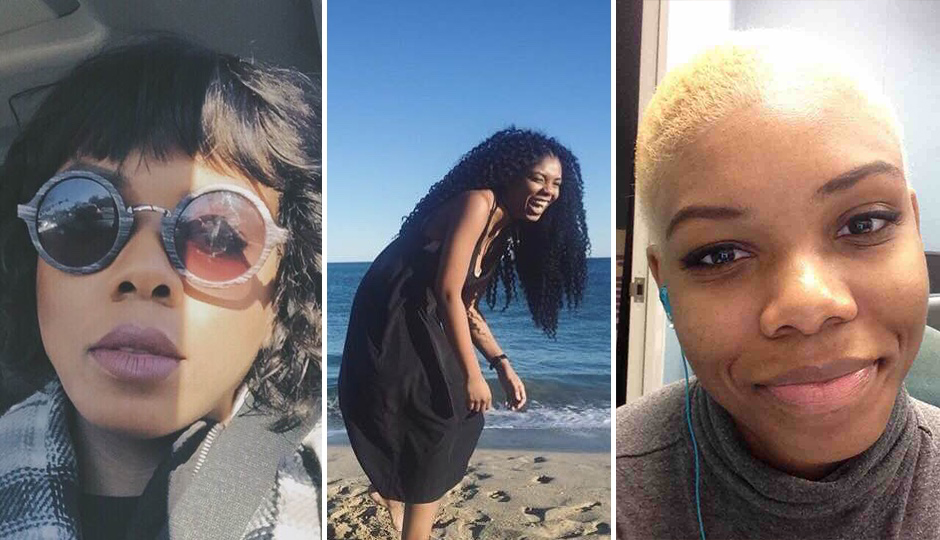What I Learned When I Shaved My Head
I went from a long-haired, all-American gal to a buzzcut blonde and it was wild.

Before and after.
There I was, standing in line to getting into some nameless club on a Saturday night in D.C., eagerly palming my ID. I was 18 and fresh from a line up and dye job at my then-boyfriend’s barbershop. I had only taken my ID picture maybe two months prior, yet I no longer looked like the girl on the card. When I handed my identification to the burly security guard, his eyes flickered over my face before he handed me back my card. And then came his remark:
“You know what, baby? You’d be real damn fine if you didn’t have that butch-ass haircut.”
After weeks of continuous haircuts and styles worthy of a movie makeover montage, I shaved my head and dyed the millimeter of hair left blonde. I’d been living my life craving other people’s approval, and I was — suddenly and finally — through with it. The combination of being away from my family and in a new city, surrounded by new people, prompted me to do something drastic, something I had never seriously considered before. So I bought some shears and haphazardly buzzed off my what was left of my over-processed hair. I finally felt liberated — free! — of all the social standards I had been unknowingly playing into. I realized that my hair (or lack thereof) suddenly had a lot of meaning — but at the same time, very little at all.
My buzz cut allowed me to confront some long-held beliefs about what I was supposed to look like being black and a woman in the 21st century. There was an overwhelming concern from others about whether I was even desirable to men anymore, or if future employers would call me unprofessional, or if I’d ever be able to face my Christian, Southern grandparents ever again. But you know what? For the first time, I didn’t care. For the first time, I started learning how to love myself, my blackness and the little bit of androgyny I suddenly had in spades.
For most of my life, I’ve had limp, bone-straight yet annoyingly frizzy hair — courtesy of a box of Just for Me relaxer and a much-maligned hot comb — that was frequently augmented by a series of weaves with varying levels of success. My hair told a story that outwardly confirmed the narrative I was trying so hard to conform to: the story of a young, black girl who followed the rules, who was proper, who was frequently told she was “articulate” and “well-spoken” and “presentable.” I was just another girl-next-door, all-American, homecoming-queen type for the modern age. It’s a tale as old as middle-class black America, of generations of women trying to appease someone other than themselves.
I was tired of living a cookie-cutter existence regulated by the opinions of others (usually strangers, sometimes family). I was tired of feeding into the bullshit idea that the entirety of my worth as a black woman in America was inexplicably sewn into the very sew-in on my head. So I decided to take control of my own narrative and shave it all off.

Via Instagram
I started off slowly, with a very carefully researched pixie cut that still somehow managed to make me look like somebody’s auntie trying to get her groove back. However awful it might have been (think less Halle Berry and more spunky bichon frise), it was an experience. I no longer felt confined to the basic, stiff ponytails of my youth and was free to explore all facets of my identity at the intersection of blackness and womanhood.
First, there was the braided top-knot situation; then a pageboy bob that got rave reviews in Europe, followed by a pixie cut that finally did read more Halle Berry than Auntie Bethel. Then came the waist-length crochet braids, and later a bright purple TWA (teeny, weeny afro) and many, many more. They were all so vastly different than what I was used to, and I was reveling in it. Finally, I was embracing a funky, weird, kind of masculine and very black side of me that had been meaning to get out for ages.
This was right around the time I began fielding unwanted comments and wide-eyed stares from strangers on a daily basis. If I handed someone my ID (much like the jerk security guard at the club), they would almost always coo how pretty I used to be with long, straight hair. If I walked around with a big, curly ‘fro, people would longingly reach toward my scalp and ask if it was real (and so what if it’s not, Random Person I Don’t Know?). When I would ignore a group of guys catcalling (if they even spared me a glance at all), they felt the need to shout words unfit for publication, almost always relating to my now-dubious sexual orientation. I don’t know what it is about a black woman’s hair that makes it a public entity.
In experimenting with my hair, I’ve learned that while it’s very easy to disregard hair and say that it doesn’t matter, it does. It can be used as a form of self-expression, as a way to challenge established social norms or as a simple fuck you to the haters — and that significance shouldn’t be disregarded. After chopping off all of my hair, I learned that while my identity isn’t inexorably tied to my hair, I can definitely use it as a tool to express myself; that my hair isn’t “my crown” if I don’t want it to be; that I am so much more than my hair and yet it still tells a major part of my story. Learning how to embrace that dichotomy is what shaving my head taught me — and it was a much-needed lesson.
